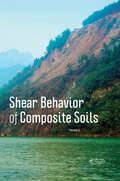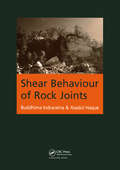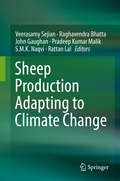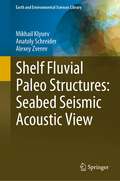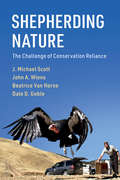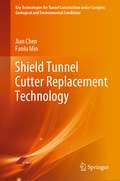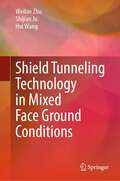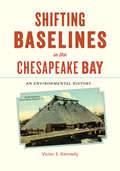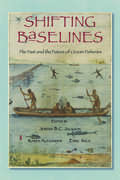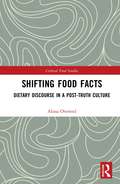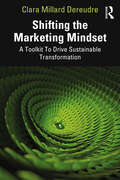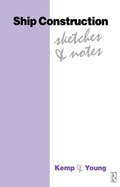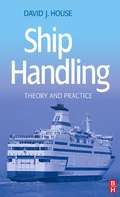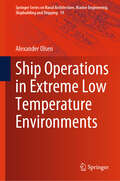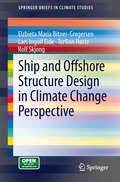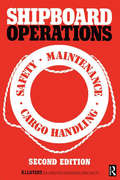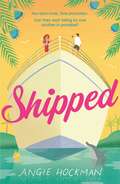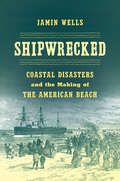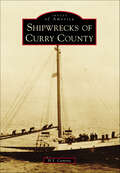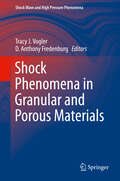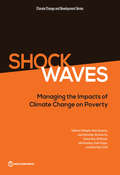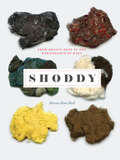- Table View
- List View
Shear Behavior of Composite Soils
by Yanrong LiThis book has the purpose of developing an understanding of the factors determining and influencing the shear behavior of soils, with emphasis on composite soils, as they are the most encountered materials in geological and geotechnical engineering in mountainous areas. This objective is reached by examining the soil compressibility, structure of shear zone and its evolution, and water content of shear zone and shear mode of soils together with analyses of the influences of intrinsic properties, e.g. Atterberg limits, particle size distribution, particle shape, and testing conditions, e.g. normal stress and shearing rate. An in-depth review is presented in an approximately chronological order and covers almost all the factors that are believed to influence the mechanical behavior of soils. The equipment and test techniques for shear strength of soils are detailed. The residual shear behavior of composite soil is investigated by means of a systematic laboratory testing program using a large ring shear apparatus and an intermediate direct shear box. The Fast Fourier Transform is employed for the first time to analyze the fluctuations of measured shearstress and discovers the close relationships with both intrinsic properties of soils and testing conditions. Although the book is aimed primarily at researchers in geological and geotechnical engineering, it contains material of interest to students of geology and soil science and also should be a useful reference for practicing engineers faced with composite soils.
Shear Behaviour of Rock Joints
by Asadul Haque Buddhima IndrarataThis title covers the fundamental properties of rock joints, the method of laboratory testing of rock joints, and shear strength assessment under different loading conditions. This work is intended as a reference text for students and practitioners in mining and rock engineering.
Sheep Production Adapting to Climate Change
by Raghavendra Bhatta Rattan Lal Veerasamy Sejian John Gaughan Pradeep Kumar Malik S. M. K. NaqviThis book presents a compilation of the latest findings from reputed researchers around the globe, covering in detail climate change and its effects on sheep production. In the current global climate change scenario, information related to its impact on livestock agriculture is lacking. The negative impacts of climate change are already being felt by all livestock species. Further, the mitigation and amelioration strategies that are applicable for one species may not hold true for another. As such, concerted research efforts are needed to identify species-specific strategies for mitigation and adaptation. With that goal in mind, this book is the first of its kind to gather comprehensive information pertaining to the impact of climate change on various aspects of sheep production. It also sheds light on the role of sheep with regard to the global greenhouse gas pool. The book highlights the status quo of sheep production from climate change perspectives and projects the significance of adapting future sheep production to the challenges posed by climate change. It addresses in detail the various adaptations, methane mitigation and amelioration strategies needed to sustain sheep production in the future. In addition, the book presents development plans and policies that will allow the sheep industry to cope with current climate changes and strategies that will lessen future impacts. Bringing together essential information prepared by world-class researchers hailing from different agro-ecological zones, this book offers a unique resource for all researchers, teachers and students associated with sustaining the sheep production in the face of global change.
Shelf Fluvial Paleo Structures: Seabed Seismic Acoustic View (Earth and Environmental Sciences Library)
by Mikhail Klyuev Anatoly Schreider Alexey ZverevThe book considers the riverine paleo structures of the coastal marine zone from the point of view of marine bottom seismic acoustics. The authors describe the mechanisms of the origin and features of riverine paleo structures in the coastal marine area. The methods applied for this kind of research have been developed and explained comprehensively, including geomorphology and interpretation of seismic acoustic facies. Besides, the authors also propose a classification of morphological features, signs and technology of recognition, as well as methods for mapping of coastal river facies supported by an extensive list of literary sources is given. The book will be of interest to marine geophysicists, marine geologists, and those interested in new methods to approach marine problems worldwide.
Shepherding Nature: The Challenge of Conservation Reliance
by John A. Wiens Dale D. Goble J. Michael Scott Beatrice Van HorneGlobally, more and more species are at risk of extinction as the environment and climate change. Many of these species require long-term management to persist - they are conservation-reliant. The magnitude of this challenge requires a rethinking of how conservation priorities are determined and a broader societal commitment to conservation. Choices need to be made about which species will be conserved, for how long, and by whom. This volume uses case studies and essays by conservation practitioners from throughout the world to explore what conservation reliance is and what it means for endangered-species management. Chapters consider threats to species and how they are addressed, legal frameworks for protecting endangered species, societal contexts and conflicts over conservation goals, and how including conservation reliance can strengthen methods for prioritizing species for conservation. The book concludes by discussing how shepherding nature requires an evaluation of societal values and ethics.
Shield Tunnel Cutter Replacement Technology (Key Technologies for Tunnel Construction under Complex Geological and Environmental Conditions)
by Jian Chen Fanlu MinThis book proposes the tool change methods for the excessive tool wear in the construction rules of shield tunnel construction in China. From the perspective of shield tunneling, atmospheric pressure tool change, pressure opening and tool change, and other special techniques, the tool change technologies are proposed. It highlights a number of tool-changing techniques and research and development work, including pressure-changing tools, tool-changing tools in the tool-cylinder arm, and cutter-tooth cutter inter-change since the beginning of the construction of the Nanjing Yangtze River Tunnel.
Shield Tunneling Technology in Hard-Soft Uneven Stratum and Extremely-Soft Stratum (Key Technologies for Tunnel Construction under Complex Geological and Environmental Conditions)
by Kairong HongThis book focuses on some technical problems encountered in shield tunneling in hard–soft uneven stratum and extremely soft stratum, based on the recent shield tunneling engineering practice, and summarizes the achievements of shield tunneling in view of the technical problems from an overall and objective perspective. There are 6 chapters in this book. Chapter 1 introduces the development trend of shield tunneling method, defines classification of various stratum where shield tunneling applies, and mainly analyses the selection of shield machines and the configuration of cutters. Chapters 2 to 5 elaborates the strata characteristics and construction difficulties under various stratum conditions, puts forward adaptive selection and design keys of shield in various stratum, and emphatically analyses and summarizes the stability control technologies of shield tunnel face and driving control technology by case studies. Chapter 6 introduces the shield chamber opening technologies under hyperbaric condition, emphatically presents the basic requirements and operational preparations for the shield chamber opening, and puts forward innovative ideas of operation procedures, control points of key procedures, and safety requirements of shield chamber opening under hyperbaric condition.
Shield Tunneling Technology in Mixed Face Ground Conditions
by Hui Wang Weibin Zhu Shijian JuThis book introduces shield construction risks under mixed face ground condition, analyzes the shield tunneling risks, gives definitions of relevant risks and creates the theoretical system of shield tunneling technology under mixed face ground condition, that is, geology is the foundation, TBM is the key, and people (management) is the essence. The content provides numbers of targeted solutions, such as dual-mode TBM, multi-mode TBM, millisecond delay blasting for boulders, Paste HDN, auxiliary pressure balance tunneling and so on. This book can make researchers who engaged in shield tunneling to get experiences and lessons from it, so as to make the right decision during shield type selection, standardize shield tunneling, take proper action, avoid or reduce construction risks, and minimize casualties and property losses.
Shifting Baselines in the Chesapeake Bay: An Environmental History
by Victor S. KennedyThis environmental history of America’s largest estuary provides insight into how and why its former productivity and abundant fisheries have declined.The concept of "shifting baselines"—changes in historical reference points used in environmental assessments—illuminates a foundational challenge when evaluating the health of ecosystems and seeking to restore degraded wildlife populations. In this important book, Victor S. Kennedy examines the problem of shifting baselines for one of the most productive aquatic resources in the world: the Chesapeake Bay.Kennedy explains that since the 1800s, when the Bay area was celebrated for its aquatic bounty, harvest baselines have shifted downward precipitously. Over the centuries, fishers and hunters, supported by an extensive infrastructure of boats, gear, and processing facilities, overexploited the region’s fish, crustaceans, terrapin, and waterfowl, squandering a profound resource. Beginning with the colonial period and continuing through the twentieth century, Kennedy gathers an unparalleled collection of scientific resources and eyewitness reports by colonists, fishers, managers, scientists, and newspaper reporters to create a comprehensive examination of the Chesapeake’s environmental history.Focusing on the relative productivity and health of its fisheries and wildlife and highlighting key species such as shad, oysters, and blue crab, Shifting Baselines in the Chesapeake Bay helps readers understand the remarkable extent of the Bay’s natural resources in the past so that we can begin to understand what has changed since, and why. Such knowledge can help illustrate the Bay’s potential fertility and stimulate efforts to restore this pivotal maritime system’s ecological health and productivity.
Shifting Baselines: The Past and the Future of Ocean Fisheries
by Jeremy B.C. Jackson Enric Sala Karen E. Alexander Francisco Chavez Jeff Bolster Jamie CournaneShifting Baselines explores the real-world implications of a groundbreaking idea: we must understand the oceans of the past to protect the oceans of the future. In 1995, acclaimed marine biologist Daniel Pauly coined the term "shifting baselines" to describe a phenomenon of lowered expectations, in which each generation regards a progressively poorer natural world as normal. This seminal volume expands on Pauly's work, showing how skewed visions of the past have led to disastrous marine policies and why historical perspective is critical to revitalize fisheries and ecosystems. Edited by marine ecologists Jeremy Jackson and Enric Sala, and historian Karen Alexander, the book brings together knowledge from disparate disciplines to paint a more realistic picture of past fisheries. The authors use case studies on the cod fishery and the connection between sardine and anchovy populations, among others, to explain various methods for studying historic trends and the intricate relationships between species. Subsequent chapters offer recommendations about both specific research methods and effective management. This practical information is framed by inspiring essays by Carl Safina and Randy Olson on a personal experience of shifting baselines and the importance of human stories in describing this phenomenon to a broad public. While each contributor brings a different expertise to bear, all agree on the importance of historical perspective for effective fisheries management. Readers, from students to professionals, will benefit enormously from this informed hindsight.
Shifting Food Facts: Dietary Discourse in a Post-Truth Culture (Critical Food Studies)
by Alissa OverendThis book offers a much-needed reframing of food discourse by presenting alternative ways of thinking about the changing politics of food, eating, and nutrition. It examines critical epistemological questions of how food knowledge comes to be shaped and why we see pendulum swings when it comes to the question of what to eat. As food facts peak and peril in the face of conflicting dietary advice and nutritional evidence, this book situates shifting food truths through a critical analysis of how healthy eating is framed and contested, particularly amid fluctuating truth claims of a “post-truth” culture. It explores what a post-truth epistemological framework can offer critical food and health studies, considers the type of questions this may enable, and looks at what can be gained by relinquishing rigid empirical pursuits of singular dietary truths. In focusing too intently on the separation between food fact and food fiction, the book argues that politically dangerous and epistemically narrow ideas of one way to eat “healthy” or “right” are perpetuated. Drawing on a range of archival materials related to food and health and interviews with registered dietitians, this book offers various examples of shifting food truths, from macro-historical genealogies to contemporary case studies of dairy, wheat, and meat. Providing a rich and innovative analysis, this book offers news ways to think about, and act upon, our increasingly complex food landscapes. It does so by loosening our empirical Western reliance on singular food facts in favour of an articulation of contextual food truths that situate the problems of health as problems of living, not as individualistic problems of eating. It will be of interest to students, scholars, and practitioners working in food studies, food politics, sociology, environmental geography, health, nutrition, and cultural studies.
Shifting the Marketing Mindset: A Toolkit To Drive Sustainable Transformation
by Clara Millard DereudreA clarion call for marketing to return to its roots and integrate sustainability principles, this book illustrates how the marketing function can drive organizations, delighting customers and impacting positively on society and the environment.Accused of manipulation and more, marketing is one of the most misused functions and misunderstood professions. The rise of “green marketing” could have been an opportunity for the profession to exhibit its potential to transform business—but instead, there has been a turn to greenwashing, with false claims of environmental friendliness. Now, businesses must evolve, rebalancing social and environmental priorities with economic ones, and it is time for a new era: Positive Impact Marketing. Drawing on almost 30 years of experience in global marketing, management, and strategy with private, public, and nonprofit organizations, this book introduces a framework organized around four key principles, Connect 4 Impact, and shows how these principles must govern marketing to achieve the desired net positive impact. It explains why and how marketing is key to establish sustainability at the core of business models and provides marketers with a toolkit and strategies for collaborating with other business leaders in the organization to guide rapid and effective transformations.This book will be a transformative resource for leaders and managers looking to truly incorporate sustainability into their business models, marketing professionals at all levels, and MBA/BBA students with an interest in sustainable business.
Ship Construction Sketches and Notes
by Peter Young John F KempThis classic book in the Kemp and Young series has been fully revised and updated by David J Eyres, author of the well-known Butterworth-Heinemann title "Ship Construction," and will prove indispensable to the student reader. The contents cover, in numerous fully illustrated items, shipyard practices, principles of construction methods, the design and construction of the various component parts of the ship, and the overall arrangement of different types of merchant and passenger vessels.
Ship Handling
by David HouseSuitable as a training manual and a day-to-day reference, Shiphandling is the comprehensive and up to date guide to the theory and practice of ship handling procedures. Its covers the requirements of all STCW-level marine qualifications, provides expert guidance on all the hardware that marine professionals will make use of in the control and operation of their vessel and offers a broad focus on many shiphandling scenarios.
Ship Operations in Extreme Low Temperature Environments (Springer Series on Naval Architecture, Marine Engineering, Shipbuilding and Shipping #19)
by Alexander OlsenThis book recognizes the fact that the vessels' intended operational profile may vary as some vessels are intended to operate with the assistance of an ice breaker and others are intended to operate independently. The guidance provided in this book is proposed to apply to all vessels that are designed, equipped and intended to operate in low-temperature environments. Special attention is given to those vessels operating for extended periods in the Arctic regions, as this presents specific and unique challenges for vessels and crew members. The application of the guidance in this book is optional. When a vessel is designed, equipped, built and surveyed in accordance with the relevant class rules, and when found satisfactory during class notation survey, a classification notation may be granted which demonstrates the vessel's compliance with the appropriate class requirements for vessels operating in low-temperature environments. Those vessels that are designed to meet the requirements of an ice class are typically required to meet specific class rules around “strengthening for navigation in ice” or other equivalent and recognized ice class rules. Accordingly, this book also provides guidance related to the requirements which address the duration of emergency electrical power. This extended emergency power duration is expressed in hours and may be appended to the base optional class notations. To provide as much context as possible, this book refers to the most relevant international regulations and standards that are considered to be applicable. It is recommended that readers of this book refer to the most recent text of those regulations and standards when seeking to apply the guidance set out herein, as it is the intent of the book to remain consistent with the pertinent international regulations and standards developed by the global maritime industry.
Ship and Offshore Structure Design in Climate Change Perspective (SpringerBriefs in Climate Studies)
by Rolf Skjong Elzbieta Maria Bitner-Gregersen Tor Svensen Lars Ingolf Eide Torfinn HørteThis book summarizes results of longstanding research and scientific contributions from many projects and relevant working groups. It collects and evaluates wind and wave climate projections under changing climate having design needs and marine safety in focus. Potential impact of projected climate change in met-ocean conditions on ships and offshore structures is discussed and illustrated by an example of the expected wave climate change on tanker design. The monograph is intended for students, researchers and industry based engineers who want a summary of the many studies that have been carried out on climate change effects on wind and waves and their importance for design and operations of ship and offshore structures. The reader needs only a moderate knowledge of marine wind and wave climate to follow the text.
Shipboard Operations
by H I LaveryThis book covers the knowledge of shipboard operations required by candidates for professional qualification as Chief Officer and Master Mariner. It deals with the basic routines and procedures, and the many regulations governing their use, for the safe and efficient operation of merchant ships. The book is also designated a fundamental text for the Maritime Transport paper of the Chartered Institute of Transport's membership examinations. The second edition takes into account recent developments in technology and regulation, and in particular covers major international legislation on Safety of Life at Sea and on Maritime Pollution as well as recent UK regulations on occupational health and safety and on operation of ro-ro ferries.
Shipped: If you're looking for a witty, escapist, enemies-to-lovers rom-com, filled with 'sun, sea and sexual tension', this is the book for you!
by Angie HockmanPerfect for fans of Christina Lauren and Sally Thorne, escape with Shipped - the whipsmart and escapist romantic comedy that celebrates the power of second chances and the magic of new beginnings.'An extraordinary debut. Witty, romantic, and completely addictive' Lauren Layne, New York Times bestselling author of Passion on Park Avenue'Shipped is a sweet, sunny getaway of a novel with an ambitious heroine I liked right away and a hero who's *chef's kiss* a supportive dreamboat (pun intended). A vicarious enemies-to-lovers trip to the Galapagos was exactly what I needed right about now. I stan an environmentally aware romance' Sarah Hogle, author of You Deserve Each Other'Shipped is exactly what we all need right now: a rollicking rom-com with a conscience. Through lush description and sparkling prose, Angie Hockman takes us on an exhilarating journey to the Galapagos Islands and straight into the hearts of her characters. I relished every swoony second I spent reading this story, and I can't wait to see what Angie comes up with next!' Kristin Rockaway, author of She's Faking It'Witty, charming as hell, and layered with real passion for ecotourism, Shipped is a sparkling debut. The perfect slice of vacation in book form' Rosie Danan, author of The RoommateTwo arch-rivals. One promotion. Can they resist falling for one another in paradise?Marketing manager Henley Evans barely has time for herself, let alone family, friends, or dating. But when she's shortlisted for her dream promotion, the sacrifices finally seem worth it. If only Graeme Crawford-Collins, the remote social media manager/bane of her existence, wasn't also up for the position. Although they've never met in person, their epic email battles are the stuff of office legend. The task: draft a proposal on how to boost bookings in the Galápagos. The catch? They have to go on a company cruise...together. But when they meet on the ship, Henley is shocked to discover that the real Graeme is nothing like she imagined - and the line between loathing and liking is thinner than a postcard. With her career dreams in sight and a growing attraction to the competition, Henley begins questioning her life choices. Because what's the point of working all the time if you never actually live?'Enchanting, hilarious and a perfectly delightful escape! I loved every second of this enemies-to-lovers romance' Nina Bocci, USA Today bestselling author of On the Corner of Love and Hate'Flirty and fun, with a starring couple you'll fall in love with, Shipped is an eco-conscious rom-com with great characters, lots of laughs, and a stunning location...I'm sold!' Sarah Morgenthaler, author of The Tourist Attraction'Angie Hockman sparkles in this unputdownable enemies-to-lovers romance!' Miranda Liasson, author of Then There was You 'Shipped is the hilarious rom-com we all need right now' Kerry Winfrey, author of Waiting for Tom Hanks'Shipped is the most wonderful escape! In this sweet, enemies to lovers rom-com, Angie Hockman seriously delivers. I can't wait to see what she brings us next!' Alexa Martin, author of Intercepted
Ships, Clocks, and Stars: The Quest for Longitude
by Richard Dunn Rebekah HiggittAn illustrated history of an eighteenth-centuury British act of parliament and the heated race to find a ship’s precise longitude at sea.A tale of eighteenth-century invention and competition, commerce and conflict, this is a lively, illustrated, and accurate chronicle of the search to solve “the longitude problem,” the question of how to determine a ship’s position at sea—and one that changed the history of mankind.Ships, Clocks, and Stars brings into focus one of our greatest scientific stories: the search to accurately measure a ship’s position at sea. The incredible, illustrated volume reveals why longitude mattered to seafaring nations, illuminates the various solutions that were proposed and tested, and explores the invention that revolutionized human history and the man behind it, John Harrison. Here, too, are the voyages of Captain Cook that put these revolutionary navigational methods to the test.Filled with astronomers, inventors, politicians, seamen, and satirists, Ships, Clocks, and Stars explores the scientific, political, and commercial battles of the age, as well as the sailors, ships, and voyages that made it legend—from Matthew Flinders and George Vancouver to the voyages of the Bounty and the Beagle.Featuring more than 150 photographs specially commissioned from Britain’s National Maritime Museum, this evocative, detailed, and thoroughly fascinating history brings this age of exploration and enlightenment vividly to life.
Shipwrecked: Coastal Disasters and the Making of the American Beach
by Jamin WellsReframing the American story from the vantage point of the nation's watery edges, Jamin Wells shows that disasters have not only bedeviled the American beach--they created it. Though the American beach is now one of the most commercialized, contested, and engineered places on the planet, few people visited it or called it home at the beginning of the nineteenth century. By the twentieth century, the American beach had become the summer encampment of presidents, a common destination for millions of citizens, and the site of rapidly growing beachfront communities. Shipwrecked tells the story of this epic transformation, arguing that coastal shipwrecks themselves changed how Americans viewed, used, and inhabited the shoreline.Drawing on a broad range of archival material--including logbooks, court cases, personal papers, government records, and cultural ephemera--Wells examines how shipwrecks laid the groundwork for the beach tourism industry that would transform the American beach from coastal frontier to oceanfront playspace, spur substantial state and private investment alongshore, reshape popular ideas about the coast, and turn the beach into a touchstone of the American experience.
Shipwrecks of Coos County (Images of America)
by H.S. ContinoEuropean settlement of Coos County began with a shipwreck. The Captain Lincoln wrecked on the north spit of the Coos Bay in January 1852. The crewmen built a temporary camp out of the ship�s sails and named it �Camp Cast-Away.� This was the first white settlement in the area. The men eventually traveled overland to Port Orford, where they told other settlers about the Coos Bay and its many natural resources. By December 1853, Coos County was established by the territorial legislature, and several towns were founded; the history of the area had been completely altered by a single shipwreck.
Shipwrecks of Curry County (Images of America)
by H.S. ContinoHistorically, mariners considered the Oregon coast one of the most dangerous in the world. In 1852, explorers discovered gold in the rivers and along the beaches in Curry County, which is located in the southwestern corner of the state. Subsequent settlement concentrated on the coast. With few roads, water transportation was crucial for early settlers. The area contained many potential dangers to ships, including unpredictable weather, frequent fog, and submerged rocks and reefs. There have been many shipwrecks in the area like that of the tanker Larry Doheny, which was torpedoed by a Japanese submarine during World War II. Curry County is home to Cape Blanco, the second most westerly point in the continental United States, and Port Orford, the only open-water port on the Oregon coast (and one of only six "dolly" ports in the world). Modern technology and port improvements have reduced the number of shipwrecks, but accidents still occur.
Shock Phenomena in Granular and Porous Materials (Shock Wave and High Pressure Phenomena)
by Tracy J. Vogler D. Anthony FredenburgGranular forms of common materials such as metals and ceramics, sands and soils, porous energetic materials (explosives, reactive mixtures), and foams exhibit interesting behaviors due to their heterogeneity and critical length scale, typically commensurate with the grain or pore size. Under extreme conditions of impact, granular and porous materials display highly localized phenomena such as fracture, inelastic deformation, and the closure of voids, which in turn strongly influence the bulk response. Due to the complex nature of these interactions and the short time scales involved, computational methods have proven to be powerful tools to investigate these phenomena. Thus, the coupled use of experiment, theory, and simulation is critical to advancing our understanding of shock processes in initially porous and granular materials. This is a comprehensive volume on granular and porous materials for researchers working in the area of shock and impact physics. The book is divided into three sections, where the first presents the fundamentals of shock physics as it pertains to the equation of state, compaction, and strength properties of porous materials. Building on these fundamentals, the next section examines several applications where dynamic processes involving initially porous materials are prevalent, focusing on the areas of penetration, planetary impact, and reactive munitions. The final section provides a look at emerging areas in the field, where the expansion of experimental and computational capabilities are opening the door for new opportunities in the areas of advanced light sources, molecular dynamics modeling, and additively manufactured porous structures. By intermixing experiment, theory, and simulation throughout, this book serves as an excellent, up-to-date desk reference for those in the field of shock compression science of porous and granular materials.
Shock Waves
by Adrien Vogt-Schilb Ulf Narloch Stephane Hallegatte Laura Bonzanigo Julie Rozenberg Mook Bangalore Tamaro Kane Fay David TreguerEnding poverty and stabilizing climate change will be two unprecedented global achievements and two major steps toward sustainable development. But the two objectives cannot be considered in isolation: they need to be jointly tackled through an integrated strategy. This report brings together those two objectives and explores how they can more easily be achieved if considered together. It examines the potential impact of climate change and climate policies on poverty reduction. It also provides guidance on how to create a "win-win ? situation so that climate change policies contribute to poverty reduction and poverty-reduction policies contribute to climate change mitigation and resilience building. The key finding of the report is that climate change represents a significant obstacle to the sustained eradication of poverty, but future impacts on poverty are determined by policy choices: rapid, inclusive, and climate-informed development can prevent most short-term impacts whereas immediate pro-poor, emissions-reduction policies can drastically limit long-term ones.
Shoddy: From Devil’s Dust to the Renaissance of Rags (science.culture)
by Hanna Rose ShellThe history of modern-day old clothes recycling begins with a thing called shoddy. Starting in the early 1800s, shoddy was the name given to a new material made from reclaimed wool, and to one of the earliest forms of industrial recycling. Old rags and leftover fabric clippings were ground to bits by a machine known as “the devil” and then re-used. Usually undisclosed, shoddy–also known as reworked wool–became suit jackets, army blankets, mattress stuffing, and much more. Shoddy is the afterlife of rags. And Shoddy, the book, reveals hidden worlds of textile intrigue. In Shoddy: From Devil’s Dust to the Renaissance of Rags, Hanna Rose Shell takes readers on a journey to discover shoddy, from Haiti to the “shoddy towns” of West Yorkshire in England, to the United States, back in time to the British cholera epidemics and the American Civil War, and into agricultural fields, textile labs, and rag-shredding factories. Shell’s narrative is both literary and historical, drawing on an extraordinary range of sources, from court cases to military uniforms, mattress labels to medical textbooks, political cartoons to high art. Shoddy moves between genres, bringing richly drawn characters and unexpected objects to life. Along the way, shoddy becomes equally an evocative object and a portal into another world. Almost since the time it first appeared, shoddy was both ubiquitous and controversial. In part because it was often so hard to detect, it was inherently suspicious. Public health experts worried about sanitation and disease—how could old clothes be disinfected? As well, the idea of wearing someone else’s old clothes so close to your own skin was discomforting in and of itself. Could you sleep peacefully knowing that your mattress was very likely to be stuffed with dead soldiers’ overcoats? The use of the term “virgin” wool, the idea of virginity in relation to clothes, in fact emerged as an effort by the wool industry to counter shoddy’s appeal: to make shoddy seem shoddy. Over time, shoddy would capture a host of personal, ethical, commercial, and societal failings. And yet, there was always, within shoddy, the alluring concept of regeneration, of what we today think of as conscious clothing, eco-fashion, sustainable textiles. Shell exposes an interwoven tale of industrial espionage, political infighting, scientific inquiry, ethnic prejudices, and war profiteering. Discarded clothes may make many journeys over the course of several lifetimes. Not only in your garments, but under your rug, in your mattress pads, piano blankets, in the peculiar confetti-like stuffing in your mailing envelopes, even in the insulation in your walls. Though it began with wool, over the past century the shredding “devil” has turned to synthetics from nylon stockings to Kevlar. Shoddy is likely connected to something you are wearing right now. After reading, you will never use the word shoddy or think about your clothes, the environment, sustainability, or the intermingled world around you the same way again.
